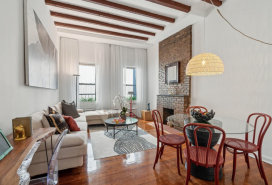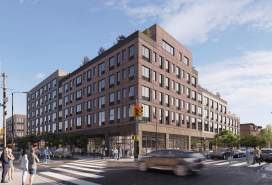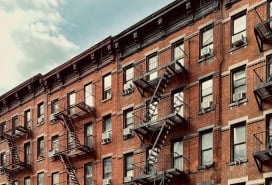NYC Renovation Chronicles: The high cost of staying put

Believing that the inconvenience and cost of temporarily relocating is far worse than putting up with a little construction, first time renovators are often tempted to live at home through their renovation.
This is rarely a wise decision. Unless you are able to hermetically seal the area of construction from the rest of your apartment, be prepared for a mess that will make camping seem cushier. Personally, I prefer a bed free of sawdust and always try to convince my clients they will too.
Here are my arguments:
Dust and debris
In NYC, where black is de rigueur, and dry cleaning is a weekly budget line item, dust is a serious matter. Despite even the best protection--such as zippered double plastic walls and daily construction site clean-up--your closets will be infiltrated by sawdust and fine white gypsum wallboard powder. There is also a lot of junk in your walls that will spill out when they are opened--particularly in prewar buildings – pebbles of plaster and lath, crumbled insulation, splinters of wood framing, an assortment of wires… Several years ago, I saw a contractor uncover dozens of oyster shells – the remnants of an 18th century construction workers’ lunch.
Noise
Two floors away, the sound of demolition is disturbing. On-site, you will have front row seats to a serenade of screeching table saws and pneumatic screw guns. Even if you normally run to work well before the construction crew arrives, there probably will be occasions when you and the workers are sharing the space. During those instances, forget about phone calls. And for napping you might consider a quieter place such as Bowlmor Lanes.
Schedule
The construction process works most efficiently when it is linearly sequenced. Ideally, demolition – the first trade – is followed by sub-flooring work, which is followed in turn by wall and ceiling framing. During framing, plumbers and electricians are brought in to run the piping and wiring that will be hidden in the walls. When this work is complete, the walls and ceilings are closed. Then the finishes such as wood flooring, tile or paint are applied and finally, the plumbing fixtures, light fixtures and millwork are installed.
If an apartment is occupied during construction, this linear process becomes more like a game of hopscotch, where work can be done in some areas and not in those that are occupied. As spaces are completed, the residents relocate to them, allowing the contractors to jump into the remaining areas. In such cases, workers such as plumbers and electricians, who normally come in for one stretch of time to do their work, are now required to go away and return. This phasing process adds a lot of time and expense to the job.
Moving costs
Sometimes people agree to vacate the premises during construction but insist on leaving their belongings compressed in a pile to be relocated from room to room as the focus of work shifts. This invariably leads to arguments and change orders from the contractors who never anticipated working as movers when they submit their bids.
If you are living in your apartment, you will need to keep some of your things there, but it is not realistic to believe you can keep everything there. Some of your stuff will need to go into storage somewhere, which presents its own set of risks. I had one job where clients of mine, believing the contractor’s schedule to be accurate, neatly boxed all their winter wear and placed it in storage only to find that the contractor was off in his schedule by a season and a half. That winter I saw a lot of new knitwear.
Higher construction cost
Contractors compensate for all these issues – added time for sequencing, the trouble of additional clean-up, the unpredictability of the residents’ habits – by increasing their price by anywhere from 20 to 40 percent. As far as I’m concerned, that’s money that should go towards a comfortable short-term rental somewhere.
But all this stated, there are circumstances that make occupying one’s space during construction less problematic than it could be - if all the work will occur in a kitchen that can be temporarily walled off, for example, that can be accessed entirely by a service door. Similarly, if the apartment is a duplex and work is occurring only on one floor, staying put isn’t out of the question. But even in these cases it is important to have a discussion with your general contractor before the work begins to understand the effect the work will have on your life and vice versa.
More importantly it is critical that you like each other. Roommates, after all, should always get along.
David Katz (www.KATZarch.com) has been practicing architecture in New York City for the last 20 years. Detail oriented, nervous and a little neurotic, he specializes in co-op and condo renovations.
Disclaimer: Information provided herein is not to be construed as professional advice. Readers are urged to consult with a licensed architect regarding their specific circumstances prior to undertaking any renovation work. (We do not want any buildings falling down!)
See all NYC Renovation Chronicles.
Related posts:
Approval, schmoovel! Renovation perks for board members
4 neat ways to use an investigative lawyer in a co-op or condo
NYC Real(i)ty Speak: Renovate THIS
Dear Ms. Demeanor: The board shot down our renovation plans and now they're ignoring us


























